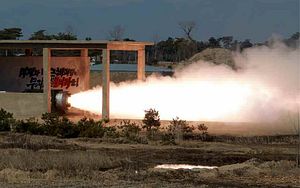North Korean ballistic missile scientists carried out a static test of a new type of solid-fuel engine early last week, a U.S. government source with knowledge of North Korea’s ballistic missile programs told The Diplomat. According to the source, the test took place at North Korea’s solid-fuel engine testing site in Hamhung, on the country’s east coast.
The test is the first reported static solid-fuel test since March 2016, when North Korean Supreme Leader Kim Jong-un inspected the test of what North Korean state media described as a “high-powered solid-fuel rocket engine and stage separation.” The engine was tested in a horizontal configuration unlike North Korea’s vertically configured tests of large liquid-fuel ballistic missile engines.
In September 2017, Japan’s Asahi Shimbun had reported a failed test of a new solid-fuel engine for a submarine-launched ballistic missile at Sinpo, but The Diplomat was unable to confirm that such a test had taken place. North Korea is not known to carry out engine tests at Sinpo, which remains largely dedicated to ship and submarine-building.
Where Will the Engine End Up?
To date, large solid-fuel engines have been associated with North Korea’s Pukguksong (Polaris) family of ballistic missiles. The March 2016 engine was first seen on the KN11/Pukguksong-1 submarine-launched ballistic missile (SLBM), which had started out as a liquid-fueled system and eventually shifted to a solid-fuel design.
In February 2017, North Korea flight-tested another solid-fuel missile: the medium-range KN15/Pukguksong-2, which was effectively a canisterized, ground-launched version of the Pukguksong-1 operating out of an integrated transporter-erector-launcher.
Kim Jong-un declared the Pukguksong-2 operational earlier this year after a second flight test and called for its mass production. U.S. military intelligence has detected signs that the Pukguksong-2 has entered serial production in North Korea, The Diplomat has learned.
It’s unclear what missile the engine tested in October 2017 may be associated with. The Diplomat was unable to ascertain if the engine tested was similar in size to the March 2016 test or if it may have been larger. However, U.S. military intelligence has assessed the engine to be different from what was tested in March 2016.
North Korea may be developing a third missile in the Pukguksong series, the Pukguksong-3. So far, only one piece of evidence exists to suggest that such a missile may exist. In late-August, when Kim Jong-un toured the Chemical Material Institute of the Academy of Defense Science, one state media image showed a poster in the facility for a two-stage SLBM under the label “Pukguksong-3.”
Such a missile may incorporate an advanced lightweight airframe built out of composite materials, which were also featured in that visit. All else being equal, such a missile should demonstrate greater range for identical payloads than the Pukguksong-1 and Pukguksong-2 given the lower weight of the airframe.
Additionally, North Korea is known to have carried out multiple ejection tests of an SLBM on land this summer. U.S. intelligence recorded ejection tests at North Korea’s primary submarine shipyard at Sinpo on May 30, July 18, July 25, and July 30.
However, that Kim Jong-un presumably did not observe last week’s solid-fuel engine test may suggest that it involved an iterative design on the existing Pukguksong-1/2 engines. Had Kim observed the test, North Korean state media would likely have announced his visit to the site and even released images.
Solid Propellants and the Future of North Korea’s Missile Program
Solid propellants will likely play an important role in the future development of North Korea’s ballistic missile program. At an April parade this year, North Korea demonstrated two large intercontinental-range ballistic missile-sized canisters that may suggest a longer-term aspiration for large road-mobile solid-fuel missiles like China’s DF-41 or Russia’s Topol-M.
Outside of the two flight-tested Pukguksong missiles, North Korea is known to only use solid propellants for its rocket artillery or the KN02/Toksa, a close-range ballistic missile.
Solid propellants, though more difficult to manufacture than their liquid counterparts, can provide a range of important strategic benefits. Unlike liquid-fuel missiles, which mostly have to be fueled prior to use, solid propellants are cast into the missile’s casing and can thus be moved into position and launched with less warning.
Another benefit of this property of solid propellents is that missiles using this type of fuel can remain fueled for a much longer duration. Liquid propellants and oxidizers are highly volatile and corrosive and most missiles designed to use them for propulsion are not designed to store them for long periods of time.
Moreover, unlike liquid missiles that may require extensive support equipment like fuel trucks in the field, solid-fuel missiles—especially those on road-mobile launchers—may be both more survivable and less prone to preemptive attack.
Solid propellants do have certain disadvantages as well. For instance, a solid propellant engine, once ignited, cannot be shut off until all the fuel has burned out. Moreover, over years of storage and movement, solid propellants cast into missile bodies can develop cracks, bubbles, and other imperfections that could cause the entire missile to fail shortly after launch.

































